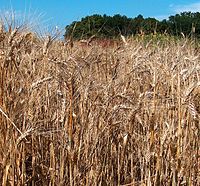
Photo from wikipedia
In the semi-arid regions of North Dakota and Montana, low annual precipitation favors production of high-quality durum wheat (Triticum turgidum L. ssp. durum). However, conducive weather conditions for disease epidemics… Click to show full abstract
In the semi-arid regions of North Dakota and Montana, low annual precipitation favors production of high-quality durum wheat (Triticum turgidum L. ssp. durum). However, conducive weather conditions for disease epidemics have occurred more frequently in recent years. Modification of planting date can reduce disease risk by decreasing the timeframe a susceptible crop overlaps with conducive disease conditions. The effect of planting date on fungal leaf spotting diseases (leaf spot), ergot, Fusarium head blight (FHB), and yield of durum was evaluated in eleven experiments across four sites in eastern Montana and western North Dakota. Six durum cultivars with differing levels of susceptibility to leaf spot and FHB were planted at three planting dates from 2017 to 2019. Early planting maximized yield and influenced ergot incidence. While there was no effect of planting date, reduced susceptibility to leaf spot and FHB was associated with a reduction in leaf spotting disease severity and deoxynivalenol (DON) respectively in the harvested grain. Growers in the semi-arid regions of these states should prioritize the selection of disease resistant cultivars to help manage sporadic disease outbreaks and continue to plant early to maximize yield.
Journal Title: Plant disease
Year Published: 2022
Link to full text (if available)
Share on Social Media: Sign Up to like & get
recommendations!